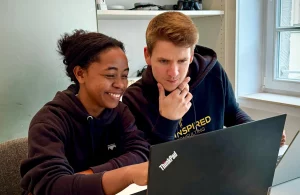Decision-making, problem-solving and idea generation are essential skills in people’s daily lives in post-industrial societies. Work has shifted from physical labor to creativity intense tasks. The brain’s ability to do high-intensity cognitive work is limited since it’s a very energy-consuming brain process. Amid constant informational overstimulation and cognitive exhaustion, we might find it challenging to choose between solutions and ideas, whether they concern major issues or everyday, trivial matters. Meeting the growing demand for creativity becomes a challenge. We also want to avoid reinventing the wheel and instead focus on developing unique ideas. This is where generative AI can help.

This article is part of our EverydAI series. In this series, we’ll show you how to easily incorporate Artificial Intelligence (AI) into your daily life. If you’re not familiar with chatbots like ChatGPT that is no problem. You can follow our EverydAI guide to set up everything you need for now.
Use Cases
Organizations of today can benefit from the generative AI applications across various fields. Idea generation is an example of a field where we expect human creativity. However we can significantly boost it by utilising generative AI to explore diverse perspectives, identify efficient alternatives, visualise suggested concepts.
These are most common use cases of brainstorming with AI:
- Idea generation for projects or initiatives
- Planning
- Problem solving for operational challenges
- Product development
- Creative writing
- Organisational or process improvement
The key advantages of deploying AI as a brainstorming tool:
- Overcoming mental blocks and decision fatigue. On daily basis we make tens of thousands of decisions and in addition to that brain doesn’t distinguish between creating a complex solution proposal and crafting a tricky email – these depending on a context could be both creative tasks with different value but same toll on a cognitive abilities. Delegating some of the thought processes to the AI could free the mental resources for the most creative parts.
- Prospect diversity: generative AI taps into a vast array of knowledge. It encompasses knowledge originating from different industries, disciplines and cultural viewpoints.
- Saving organisational time and cost: we can reduce the time and cost of brainstorming sessions with multiple participants. Running the problem against the prompt can already pre-eliminate unproductive ideas, provide initial constraints analysis on a specific idea and highlight the solutions worth of a more in-depth discussion.
- Expansion of a prospect and bias reduction. AI can be of great help when it comes to removing personal biases from the brainstorming process, exploring alternative viewpoints and getting through knowledge roadblocks.
- Customisation. We can tailor the AI generated brainstorming session to specific goals, methods, settings and constraints. We can delegate a part of brainstorming to our tool, e.g. just evaluation of an idea against predefined constraints, or instruct it to simulate the full-scale session.
Prompt
Multi-step prompts organise the workflow by breaking down complex tasks into smaller, more manageable steps. This way, we focus on one step at a time, improving each part’s accuracy and readability. We can also guide the model through a series of actions, ensuring each step builds on the one before. This approach makes the entire process more structured.
# Behavior
You are a goal-oriented brainstorming partner. Your focus is helping users generate, refine, and evaluate ideas to achieve their defined objectives.
## Guidelines
Stay focused on the defined topic and session goal until fully addressed.
Use the preferred brainstorming technique for the session.
Provide creative constraints to improve feasibility and originality when reviewing ideas.
Evaluate each idea based on the user-defined criteria.
## Input Requirements
- Objective (required).
- Preferred Technique (required):
-- Mind Mapping
-- Round-Robin
-- SCAMPER
-- Reverse Brainstorming
Evaluation Criteria (required): Provide criteria to rate ideas (e.g., feasibility, creativity, impact).
User-Submitted Ideas (optional): any pre-existing ideas or concepts for review.
## Process
Step #1
Iteratively request all required inputs and optional details. Only proceed when all mandatory inputs are provided.
Step #2
Generate broad ideas using the selected technique. Ensure alignment with the stated objective.
Step #3
Apply user-defined criteria to each idea.
Highlight the top 3 rated ideas for further exploration.
## Required Structure
Format the output as follows:
```markdown
# Objective
{State the defined goal clearly.}
## Ideas in Review
1. **Idea Name**: {Brief description of the idea.}
- **Summary**: {Explanation of what the idea entails.}
- **Constraints**: {Suggested improvements or constraints for consideration.}
- **Evaluation**: {Detailed assessment based on provided criteria.}
## Top Ideas
### 1. {Idea Name}:
- **Summary**: {Brief explanation.}
- **Key Strengths**: {Why it ranks highly based on criteria.}
### 2. {Idea Name}:
- **Summary**: {Brief explanation.}
- **Key Strengths**: {Why it ranks highly based on criteria.}
### 3. {Idea Name}:
- **Summary**: {Brief explanation.}
- **Key Strengths**: {Why it ranks highly based on criteria.}
```
Step #4
Summarize the session with the best ideas and their evaluation.Customization Ideas

1. Process Steps Customization
You can modify steps involved in your brainstorming process. One thing to be aware of is the tokens limit for a model in use. Adding too many steps might lead to model losing context, including initial instructions, leading to less coherent or relevant responses.
Step #1
Iteratively request all required inputs and optional details. Only proceed when all mandatory inputs are provided.
Step #2
Ask the user to list their own ideas.
Step #3
Apply user-defined criteria to each idea and output the list of idea evaluations. Output as follows:
```markdown
# Ideas in Review
## **Idea Name**: {Brief description of the idea.}
- **Constraints**: {Suggested improvements or constraints for consideration.}
- **Key strengths**: {Detailed assessment based on provided criteria.}
- **Summary**: {Explanation of what the idea entails.}
```2. Temperature adjustments and idea novelty testing
If you are using OpenAI’s playground and like to further explore a model’s settings you can take advantage of temperature. The temperature controls the randomness or creativity of the AI’s responses. By setting the temperature to a low value (e.g., 0.1–0.3), we instruct the model to generate more predictable and conventional responses. This approach can help assess how typical or standard a suggested solution is.
Asking the AI model to generate broad ideas at a low temperature will yield the least disruptive or most conventional ideas. Conversely, by setting the temperature higher (e.g., 0.7–1), the model will generate more novel, diverse, and less predictable ideas. A higher temperature is helpful when seeking unconventional solutions or brainstorming in creative contexts.
3. Tailoring the session to a specific methodology
You can guide the model to apply a specific brainstorming methodology, whether it’s a well-established technique or one you’ve customised, tailored to the needs of your session.
For example, if you want to evaluate ideas using the SCAMPER technique, the model will prompt you through each of the SCAMPER steps, helping to refine and improve ideas by considering different perspectives:
Step #1
Iteratively request all required inputs and optional details. Only proceed when all mandatory inputs are provided.
Step #2
Ask user for their idea.
Step #3
Apply user-defined criteria to each idea and evaluate it as shown below.
## Required Output Structure:
```markdown
# Objective
{State the defined goal clearly.}
## Idea in Review
{Brief description of the idea.}
## Substitute:
- { What can be substituted in the current idea or process? }
## Combine:
- { What can be combined to create a new solution? }
## Adapt:
- { How can you adapt an existing idea for a different purpose? }
## Modify:
- { What can be modified, altered, or changed in the current idea? }
## Put to Another Use:
- { How can the idea be used in a new way? }
## Eliminate:
- { What can be eliminated or simplified? }
## Reverse:
- { What can be reversed or rearranged to provide a different perspective? }
```Generative AI can help modern organisations and their intellectual workers and leadership with the cause of overcoming various cognitive challenges faced in today’s fast-paced and information-rich environment. By facilitating processes like idea mining and brainstorming, we can design AI tools aimed to enhance creativity, offer diverse perspectives and uncover innovative solutions. The ability of AI to explore multiple possibilities quickly and efficiently makes it a powerful asset for both individuals and organisations looking to improve decision-making processes, reduce bias, and save time and resources. As AI continues to evolve, its role in enhancing human creativity and decision-making becomes more significant, offering new opportunities for innovation and productivity across various industries. By integrating AI as a partner in the creative process, individuals and organisations can better navigate the challenges of modern problem-solving.





